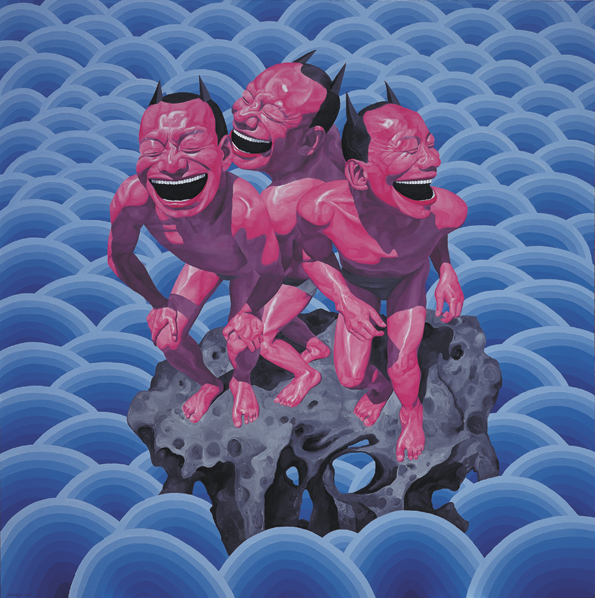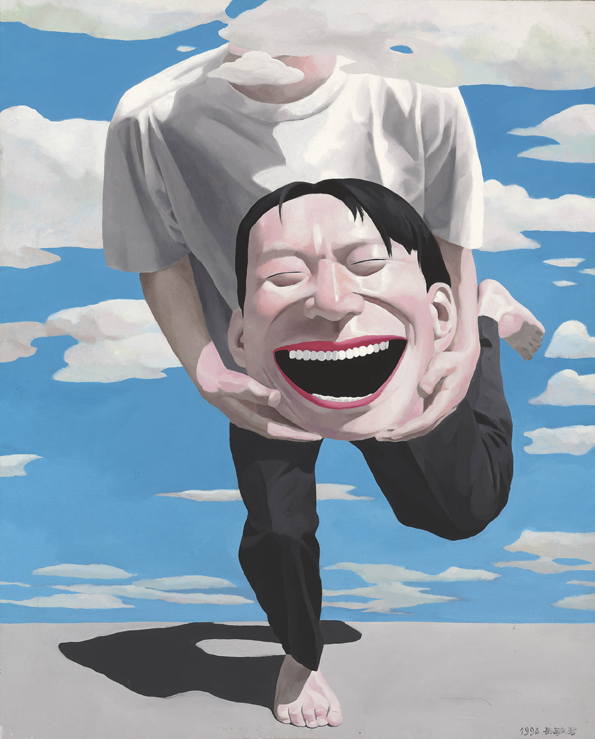by Erik Matiny
About Erik Martiny
 Erik Martiny's reviews have appeared in London Magazine and The Times Literary Supplement. He lives in France.
Erik Martiny's reviews have appeared in London Magazine and The Times Literary Supplement. He lives in France.
Yue Minjun : L'Ombre du fou rire, Fondation Cartier, 268pp, £30 (hardback)
Born in 1962 in Daqing, China, Yue Minjun studied art at the Normal University in Hebei Province. After having joined the (now no longer existing) Yuan Ming Yuan community of artists outside Beijing in the early 1990s, he began to explore the theme of laughter and its subversive value. He is often considered as one of the major exponents of Cynical Realism, which is read as a response to the static political situation in China and the disillusion that ensued after the Tiananmen Square massacre in 1989. He continues to sculpt and paint in his studio in Beijing.
In 1999, Minjun created a sensation at the 48th Venice Biennale, rising to international fame. His venues for solo exhibitions include Klaus Littmann Gallery in Basel (1997), SooBin Art Gallery, Singapore (2002), Galerie Urs Meile, Lucerne (2003), CP Foundation, Jakarta (2005), Queens Museum, New York (2007), Arhus Kunstmuseum, Aarhus (2011), Shanghai Gallery of Art, Shanghai (2010).

Isolated Island by Yue Minjun
Ever since the '85 New Wave movement in China, when visiting students came to Beijing from the Ecole des Beaux-Arts de Paris, the two capitals have enjoyed a special relationship. Chinese artists in political exile have also tended to settle in Paris. It's not hard to see why Yue Minjun agreed to send his works to the prestigious Fondation Cartier for the venue of his first major exhibition in Europe earlier this year. The see-through building that houses the foundation comes as a welcome counterblast to the political opacity that Minjun denounces in his work. The wild, tiered garden that extends behind the gallery also contains a number of startling, massive, gaudily orange armchairs that add another surreal touch to Minjun, the Magritte of the Oriental world.
The ground floor of the exhibition displayed Minjun's first iconic works as well as some recent ones: they could be viewed at eye-level and from a higher angle if you walk up to the transparent bookshop on the first floor. The basement contained a series of new sketches alongside the artist's most recent painted departures from what Richard Vine called Minjun's 'transcultural iconicity,' in his ground-breaking critical work New China New Art (2011). The catalogue to this exhibition, L'Ombre du fou rire, contains photographs of all the exhibits and more: There are interviews, poems, and essays inspired by his work and shots of his sculptures not shown at the exhibition. It's a beautiful volume with an exciting cover that's well worth acquiring.
Like Shakespeare's Prince of Denmark, Yue Minjun is patently unable to recover from the villainy of dictatorship. Although the current regime in China has softened up its stranglehold on the arts, its implacable control over the country is no less daunting than before, the freedom it allows its artists no more than a slightly longer tether. On the face of it, Beijing has generously offered its artist community the immense expanse of 798 Art Zone, a town-sized district within the capital that houses artists and galleries. In practice, painters are free to imply criticism of the government, as long as they don't incite open revolution or elicit organized hostility towards the regime.
Minjun's paintings are so scathingly satirical that they give you the impression he must be walking on the thin high-wire stretched out above the carceral abyss. Despite his work's obvious political edge, Minjun has managed to elude censorship or imprisonment through various strategies. The first is non-representation of Party members or open reference to recent political events. The Tiananmen Square massacre is brought to mind in some of his paintings only because the square itself is depicted but there are no dead bodies or blood-stained soldiers to be found; just a totally vacant square and an utterly vacuous smile.
One of the artist's early works, entitled On the Rostrum of Tiananmen (1992), is a group portrait of Minjun's friends standing casually on the official Party rostrum, the massive pedestal of power from which Mao and his successors addressed the nation. They are smoking and laughing derisively off the canvas: This is Minjun's laughter at its most wholesome, what the Chinese call 'ha ha xiao-xiao', the laughter that confounds the enemy and momentarily shakes off the shackles of power, a laughter that empowers the one who directs it at the laughable object of scorn.
Minjun's later depictions of jocular mirth are considerably more disturbing. His early mild grotesquery became unbearably hollow after 1992 when Minjun began to standardize all his figures into one mask-like face endlessly reproduced.
This tendency to duplicate the same face several times within the same painting was a staple in the work of some of the French Post-Impressionists towards the end of the nineteenth century; its ostensible aim was the replication of the various facets of beauty within the one figure, the mirroring of human perfection. Maurice Denis's A Portrait of Yvonne Lerolle in Three Aspects, for instance, makes the sitter into a timeless, triple goddess. This figuration draws on both primitive art and the near-identical faces evoked in the classical and Renaissance tradition of depicting such triads as the Three Graces.

Untitled by Yue Minjun
Minjun takes facial iteration in an entirely different direction, removing all grace from his smiles and hollow-mouthed laughs. His early, relatively wholesome, mocking hilarity seems to have irrecoverably turned into rigid mask-like laughs that merely grin and bear it in the face of political despotism.
The black-humoured laughter of the helpless in Minjun's paintings has recently also modulated into the demonic laughter of the oppressor who knows that nothing can overthrow his power. Isolated Island (2010) shows three devil-like figures enjoying a fit of Satanic giggles on a tiny strip of rock adrift in an Op-art ocean of bubbling blue paint.
Part of what makes Minjun's figures so interesting is their ambiguity. The victim's risus sardonicus is hardly distinguishable from the oppressor's cackle, as if the two had blended into a horrible hybrid. On the whole, his recent faces have become increasingly more pained as their skin color deepens towards the darker reddish hues of burn victims and the Devil rolled into one, despite the fact that China is probably a more bearable place to live in today than it was when Minjun first started painting. Perhaps this stems from his growing sense that the political situation looks set to stay the same forever. Painted in 2008, a work such as AD 3009 strongly suggests that human nature will be no less saurian a thousand years from now, leaving the viewer with the despair expressed during the final torture scenes in Orwell's 1984.
This increasing pessimism has made Minjun's work more unpleasant and disturbing in its implications, a departure from his earlier style which tended to merely imply the horror behind the smiling façade of bright clouds and the pretty blue skies of Magrittean iconography. Despite their obvious satirical intent, these early paintings sometimes run the risk of being beautiful. Although the exhibition poster depicts a headless man (fittingly named Untitled) about to kick his own laughing head away like a football, it is almost excessively cheering in its effect, possessing an irrepressibly companionable presence that lights up the room.
In his attempt to undermine the smiles of Maoist propaganda posters, you might argue that Minjun's Magrittism occasionally prettified his palette a little too much, allowing one of the traditional functions of art to come into conflict with its ability to protest. The same criticism can be leveled at Wei Dong's uneasy blending of the pornographic and the political: His eroticization of power sends a very mixed message. Perhaps this is the plight of artists in an oppressive system: Politics and beauty become hard to reconcile. Nevertheless, most of Minjun's paintings manage to find an acceptable compromise.
Like Frida Kahlo, Minjun's greatness ultimately lies in his ability to creatively expand the genre of self-portraiture. His stylized self-studies seem fundamentally to be prompted by a need to slip the leash of censorship: Using your own face as a way of exploring existential pain and satirizing the power-hungry at the same time is probably the most economical and shrewd way to escape the censor's whiplash. While artists of the past sometimes depicted themselves in the garb of Christ, Minjun succeeds in making his own face stand for both the victim and the oppressor simultaneously.
Transcending Passages, Maisoon Al Saleh, March 16th - April 6th, 2021
East Villager Billy The Artist Climbs Atop Ai Wei Wei's Fence To Shine A Light On It
Teddy Thompson’s Ultimate Funeral Mix Tape
Moray Hillary, Pre-New Reflective by Heather Zises
SELFISH, Review by Heather Zises
Winter Realm Series by Noah Becker
Paul Rousso at Lanoue Fine Art
Airan Kang, The Luminous Poem at Bryce Wolkowitz Gallery
Damien Hoar De Galvan at Carroll and Sons
Antigone, 2015, directed by Ivo van Hove
Karen Jerzyk's unsettling Parallel World
CEK - Concrete Functional Sculptures
Alexis Dahan, ALARM! At Two Rams
Do Ho Suh, Drawings, at Lehmann Maupin
Nir Hod, Once Everything Was Much Better Even the Future
Exhibition Review: Mario Schifano 1960 – 67
Subverting the Realist Impulse in the Work of Shauna Born
Linder: Femme/Objet by Erik Martiny
What We Do in the Shadows by Jemaine Clement and Taika Waititi
Justin Kimball at Carroll and Sons
Told & Foretold: The Cup in the Art of Samuel Bak, at Pucker Gallery
Collective Memory Manipulated: Sara Cwynar’s Flat Death
Art Paris Art Fair 2013 Review
Paris Street Art Musée de la Poste
Trellises by Katherine Tzu-Lan Mann
Accumulation: Sculptural work by Alben at Gallery Nines
Topography of Destruction Kemper Museum
L'art en Guerre : France 1938-1947
The Louvre Relocates to Africa
A French Priest, Tears and Fire the Art of Jean-Michel Othoniel
